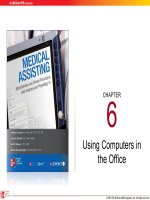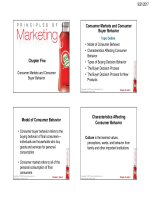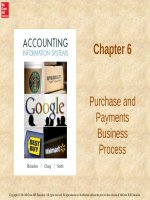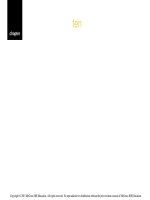Lecture M: Marketing (4/e) - Chapter 6: Consumer behavior
Bạn đang xem bản rút gọn của tài liệu. Xem và tải ngay bản đầy đủ của tài liệu tại đây (843.57 KB, 44 trang )
chapter
six
consumer behavior
Copyright © 2015 McGrawHill Education. All rights reserved. No reproduction or distribution without the prior written consent of McGrawHill Education.
LEARNING OBJECTIVES
LO 6-1
LO 6-2
LO 6-3
LO 6-4
LO 6-5
LO 6-6
Articulate the steps in the consumer
buying process.
Describe the difference between functional
and psychological needs.
Describe factors that affect information
search.
Discuss postpurchase outcomes.
List the factors that affect the consumer
decision process.
Describe how involvement influences the
consumer decision process.
62
The Consumer Decision Process
Need Recognition
Psychological needs
©Digital Vision/PunchStock
Royalty-Free/CORBIS
Functional needs
63
The Consumer Decision Process
Search for Information
Courtesy of Refinery29.com.
64
Factors Affecting Consumers’
Search Process
Perceived
Benefits
Perceived
Costs
65
The Locus of Control
Internal Locus of Control = more
search activities
Royalty-Free/CORBIS
External Locus of Control =
Fate, external factors
©Comstock/JupiterImages
66
Actual or Perceived Risk
67
The Consumer Decision Process
Evaluation of Alternatives: Attribute Sets
68
The Consumer Decision Process
Evaluation of Alternatives: Evaluate Criteria
Digital Vision/Getty Images
What are some of the features of a vacation
that would be in your evaluative criteria?
69
The Consumer Decision Process
Evaluation of Alternatives:
Consumer Decision Rules
Cheerios
10
8
6
Post
8
9
8
Kashi
6
8
10
If the consumer
8 makes
8.2 a decision
using a
compensatory
decision rule, which
cereal will they
3
7.1
choose?
If the consumer
makes a decision
based
only on
5
7.2
Natural or Organic
claims, which cereal
will they choose?
All photos: ©M. Hruby.
610
The Consumer Decision Process
Purchase and Consumption
Handout/MCT/Newscom.
611
Postpurchase:
612
check yourself
•
•
•
•
•
Name the five stages in the consumer decision
process.
What is the difference between a need and a
want?
Distinguish between functional and psychological
needs.
What are the various types of perceived risk?
What are the differences between compensatory
and noncompensatory decision rules?
613
Factors Influencing
the Consumer Decision Process
•
•
•
•
Product
Price
Place
Promotion
•
•
•
•
•
Marketing mix
Motives
Attitudes
Perceptions
Learning
Lifestyle
Psychological
factors
Consumer
Decision
Process
Social factors
•
•
•
Family
Reference groups
Culture
Situational
factors
•
•
•
Purchase situation
Shopping situation
Temporal state
614
Psychological Factors: Motives
Courtesy Taco Bell
615
Psychological Factors: Attitude
©K Rousonelos
616
Psychological Factors:
Learning and Lifestyle
Royalty-Free/CORBIS
617
Social Factors: Family
©Stockbroker/Purestock/SuperStock.
618
Social Factors: Reference Groups
619
Social Factors: Culture
620
Situational Factors
Courtesy Murphy O’Brien Public Relations/Santa Monica, CA
621
check yourself
•
•
•
What are some examples of specific needs
suggested by Maslow’s Hierarchy of
Needs?
Which social factors likely have the most
influence on (a) the purchase of a new
outfit for a job interview and (b) the choice
of a college to attend?
List some of the tactics stores can use to
influence consumers’ decision processes.
622
Involvement and Consumer
Buying Decisions
Message (e.g., Ad)
High involvement
• Greater attention
• Deeper processing
Develops
strong
attitudes
and
purchase
intentions
Low involvement
• Less attention
• Peripheral processing
Generates
weak
attitudes and
increased
use
of cues
623
Types of Buying Decisions
•
•
Extended Problem Solving
Limited Problem Solving
–
–
Impulse Buying
Habitual Decision Making
Courtesy Wendy’s International, Inc.
624
check yourself
•
•
How do low- versus high-involvement
consumers process information in an
advertisement?
What is the difference between extended
versus limited problem solving?
625









